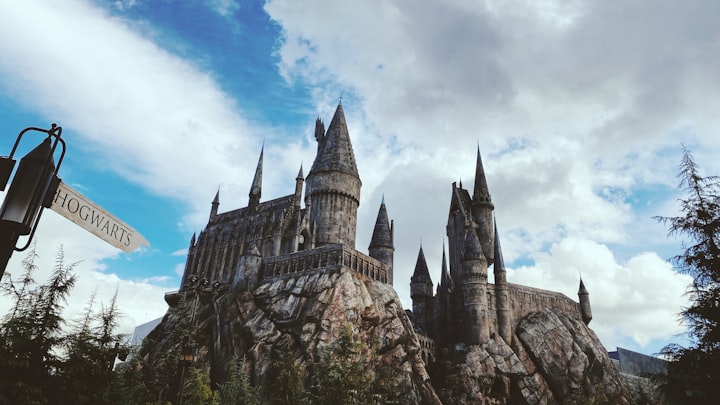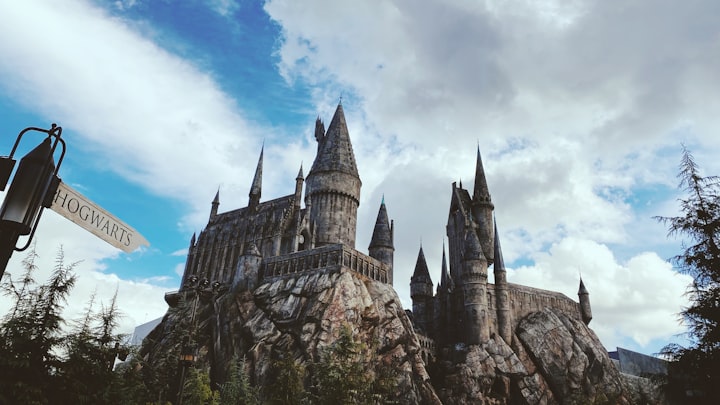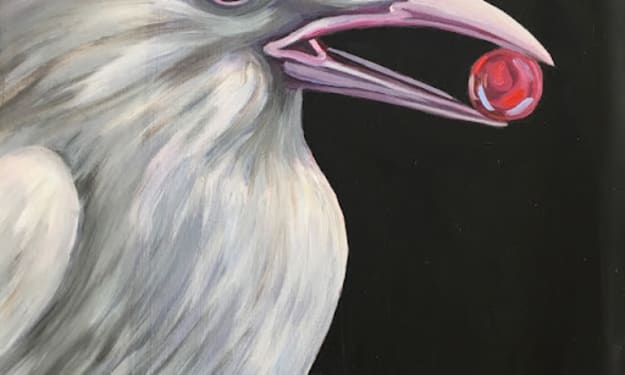Not Like Those Other Girls
Internalised Misogyny in Harry Potter

When a book has a Token Female Character, it's easy to spot and cry gender bias.
But what about when the female characters are present, but only a certain type of female character is presented positively? Surely it can't be misogyny when a female character is there saving the day! See, there are loads of girls around, the writer is clearly a feminist!
But are they?
To be fair, this isn't entirely on Rowling. There's a reason we call the auther "Rowling" and not "Joanne", or even "Joanne Rowling": because not even the publishers thought that they'd be able to market Harry Potter if it was written by an obviously female author. Hence, Rowling adding her mother's name and using the abrevation JK.
As a Traditionally-Published Author, Rowling had to go with what her publisher wanted, at least at first. It's not a new story; Fantasy legend Mercedes Lackey has spoken previously about fighting with her publishers over things she wanted to write, and even Rick Riordan, one of the big names in YA Diversity, kept things fairly tame until he was too big to stop.
In the '90s and early '00s, when Harry Potter was being written, female characters lacked a lot of the variety we see today. There was a lot of tokenism, and a need to make the sole important female character stand out by making her different to the other female characters around her.
Female Characters in Harry Potter fall into one of five categories:
- Death Eater/Death Eater-adjacent
- Sainted Mother
- Male Character Development But With Breasts
- You Are A Girl And Should Be Ashamed
- Luna Lovegood
We'll take these one at a time...

Death Eater/Death Eater Adjacent
Narcissa Malfoy, Bellatrix LeStrange, Madam Umbridge...
No one questions that these women are not good people. They are power hungry, obsessive, cruel or derisive because they can be. Justification? What's that?
I'm not saying that it wasn't awesome to see Voldemort's most feared and fanatical Death Eater be a woman, rather than the sausage-fest that was common at the time, but she is rather a stereotype.
Umbridge was the more Lawful Evil, the kind of everyday banal malice that struck so hard because every reader has known an Umbridge. Someone who knew the System and used it against you, who was blind to every reality but the one she wanted.
Narcissa Malfoy was somewhere in between. She was never shown to take an active role in terrorism, and appeared unhappy about Voldemort's return in Books 6 and 7... when it negatively affected her. Narcissa benefitted from Pureblood Privilege and the status quo, and only when she and her family were hurt or endangered, did she care to do something that coincidentally also helped the heroes.

Sainted Mother
This one is easy. Lily Potter, Molly Weasley, even Andromeda and - to a smaller extent - Nymphadora Tonks, though the latter two are more commonly in fanfiction.
Characters who are the pinnacle of idealized female virtue, who are never framed as being in the wrong even when their actions prove harmful.
Lily is easy; from the very beginning of the book, the most prominent thing about Lily was that she sacrificed her life to save her son. Even when we learn more about her, her flaws and bravery and morals, that sacrifice is still her main purpose, to the point that it's almost a character trait in and of itself.
Mrs Weasley is next. Kind, generous and maternal, she is never presented as wrong in her actions, even when those actions tip from 'protective' to 'controlling', or when she explicitly treats another character badly, like her constant snide comments to Sirius in Order of the Phoenix, or arbtarily decides, based off a Rita Skeeter article, to believe that her son's friend, a fifteen-year-old girl that Molly has met and spent time with over at least two summers, is a horrible gold digger, and makes her displeasure obvious when sending fudge to the trio over Easter.
At no point does she bother to ask Harry or Ron for the facts of the matter, or even reach out to Hermione herself. As a parent and temporary guardian for Hermione when she visits over the summer breaks, it's not a good look, and there's never really an apology, even after Harry clarifies that Hermione is only a friend and Rita Skeeter lies. But, it's Mrs Weasley, the paragon of motherhood, so everything is brushed off as a harmless mistake.
Fans might differ in their opinions depending on who their favorite characters are, but Rowling certainly seems to think that Mrs Weasley is above reproach.
Even Narcissa Malfoy counts here, because we're supposed to forget that she was a death eater in light of the fact that she lied to Voldemort to protect her son.

Male Character Development But With Breasts
Hermione. Ginny and Tonks are the main ones here, along with Amelia Bones, to an extent. The Gryffindor Quidditch Team, Cho Chang and the majority of other female characters don't really get any character development to speak of.
The female characters with the most development are well developed for female characters in the early '00s, but very little of that is female character development.
Allow me to explain. There isn't much positive interaction between female characters in the Harry Potter series. The one that comes to mind most easily is Christmas at Grimmauld Place, where Tonks is changing her nose to mimic various animals, and Ginny and Hermione are laughing.
Sure, there are scenes where multiple female characters are in the same place and engaging in conversation. Certainly, Hermione mentions things that Ginny told her off-page, Luna and Ginny have apparently been friends for years, and there's a passing reference to Mrs Weasley, Ginny and Hermione giggling over the story of a love potion. Yes, Hermione and Ginny look up to Tonks as a Cool Older Girl...
(Parvati and Lavender have a solid friendship, and Cho and Marietta will go to war for each other, even when that's narratively a bad thing, but we'll address that in the next section...)
But that's it. We're told, rather than shown, about all these positive female interactions. All the on-page interactions drive the plot, rather than developing the characters.
And the character development we do get... is fairly limited. Hermione is introduced as already knowing nearly everything there is to know, Tonks as an Auror with a rare magical talent. There is only so much further they can develop. Hermione also acts as the emotional mouthpiece, despite being socially stunted herself, and it only works because she's friends with two exceptionally oblivious boys, compared to whom she actually can be held up as the emotional intelligence of the gang.
In fact, when Hermione and Tonks do get subplots relating to femininity, particularly romantic subplots, it actually regresses their character more than it develops it.
Tonks becomes a depressive shadow of herself when Remus, a man almost twenty years older, has justified concerns about dating her, and throws a fit that compares two very different situations to get her way. Remus being an actual werewolf who probably helped Sirius babysit Tonks as an infant is not actually comparable to Bill getting badly scarred.
Hermione engages in very questionable behaviour while she's crushing on ron, from hexing Cormac McLaggen at Quidditch tryouts so Ron wins the Keeper position, to setting conjured birds on him when Ron is dating Lavender, leaving Ron bleeding. Even if both actions were spur of the moment, it's still incredibly toxic behaviour in the name of a schoolgirl crush.
Ginny had almost no character development until Book 5 and 6, when she goes from being mentioned once or twice in passing, to being the star of everything. She's the best player on the Quidditch Team, she invented her own hex, everyone laughs at her jokes even when they're mean-spirited, all the heterosexual boys are in love with her...
And all of that was something presented as Word of God/Author fact, rather than something that was built up over time. There was no mention of Ginny coming to watch Quidditch Practice over the earlier books, or studying with Hermione, or being popular - quite the opposite, in fact. That's not character development, it's plot contrivience.

You Are A Girl And Should Be Ashamed
Most of the Series's temporary love interests fall under this heading, as do a majority of the non-Quidditch-Player female characters.
Fleur Delacour, probably the most overtly feminine character in the books, falls squarely in this catagory, as do Lavender and the Patil twins, Cho Chang, Marietta Edgecombe and the majority of other female characters.
To be fair to Rowling, we as readers see the books through the eyes of a socially-stunted teenage male protagonist, and YA likes to pretend that boys and girls are two seperate species, with little to no overlap in their interests. As such, it's easy for female characters to be written off as frustrating or incomprehensible to the male main character.
That doesn't change the fact that character traits that are viewed as inherently feminine - emotion, attention to their appearence, flirting, gossip - are treated in a very negative light.
Take Cho Chang. Readers are supposed to be outraged on Harry Potter's behalf that he was left alone to deal with his grief over Cedric, and how he is very clearly not coping well. Yet, when Cho is crying over the memory of her murdered boyfriend, grieving and angry that no-one is able or willing to tell her what happened to him, we are supposed to be impatient and annoyed that Cho isn't getting over it fast enough.
Take Marietta Edgecombe. When Harry returns to Hogwarts, there is tension between him and Seamus Finnigan, who disbelieves Harry, who he has shared a room with since First Year, on the basis of "my mum said so". Seamus gets some salt for this, but it's nothing compared to the malice directed at Marietta, who has far greater resons to distrust and dislike Harry. Marietta only knows Harry through Cho and the DA, and all she really knows there is that he's a barely-decent boyfriend, who is spending more time running the very against-the-rules duelling club. Meanwhile, her mother is under pressure at the Ministry, Marietta is under pressure at Hogwarts, and there's still no real evidence that Voldemort is back, just the word of a teenager backed up by a headmaster who has a reputation for being eccentric at best. It's a no-win situation, and while selling out the DA was undeniably the wrong thing to do, it's not hard to see why it happened.
Lavender and Parvati are not shown to be shallow or vapid characters in-text. Quite the opposite, they're kind, caring and passionate about the things they're interested in. Unfortunately, those things are Divination, fashion and getting giggly over boys, so we see them as shallow. Even though Lavender faced down Fenrir Greyback, she's still seen primarily as a boy-crazy flirt.
Fleur Delacour took down a dragon with a sleeping charm. Allow me to repeat: Fleur single-handedly took down a dragon, but she's beautiful and quarter-Veela and feminine, so all we remember is that she ultimately came last in the Tournament and married Bill Weasley, not that she's a stone-cold badass.
Ginny of books one - four fits in here, too. A fangirl who initially treats Harry like a zoo exhibit, who can't string two sentances together around him, who barely exists in the narrative except as decoration. It's not until she becomes a hex-wielding, sports-playing, firey tomboy-with-model-looks that she's actually considered as a love interest.

Luna Lovegood
If Luna had to be described using a character trope, it would be a bizarre cross between Mary Sue and Manic Pixie Dream Girl.
Luna is a very intriguing character, but she does somewhat defy description, and any effort to fit her into broader catagories. She's a friend but never a love interest, feminine but quirky, popular by proxy but a social outcast...
If JK Rowling liked fitting her characters into neat little boxes, Luna is that one toy that may have fit into the packaging at one point, but once it's opened, no box in existance will fit her again.

If you want to read more Harry Potter headcanons, check them out on my Profile or the links below.
If you liked this story, leave a heart or a tip, and follow me on Vocal and Medium!
About the Creator
Natasja Rose
I've been writing since I learned how, but those have been lost and will never see daylight (I hope).
I'm an Indie Author, with 30+ books published.
I live in Sydney, Australia
Reader insights
Outstanding
Excellent work. Looking forward to reading more!
Top insights
Compelling and original writing
Creative use of language & vocab
Easy to read and follow
Well-structured & engaging content
Expert insights and opinions
Arguments were carefully researched and presented
Eye opening
Niche topic & fresh perspectives
On-point and relevant
Writing reflected the title & theme






Comments
There are no comments for this story
Be the first to respond and start the conversation.